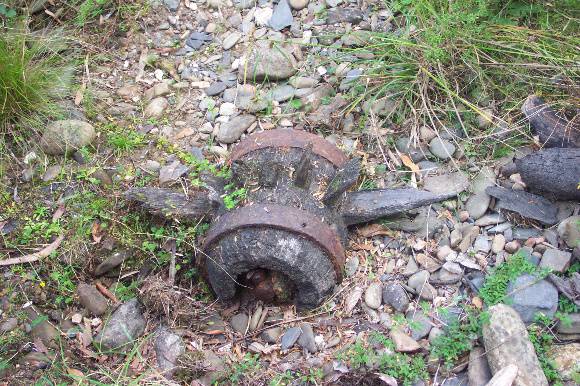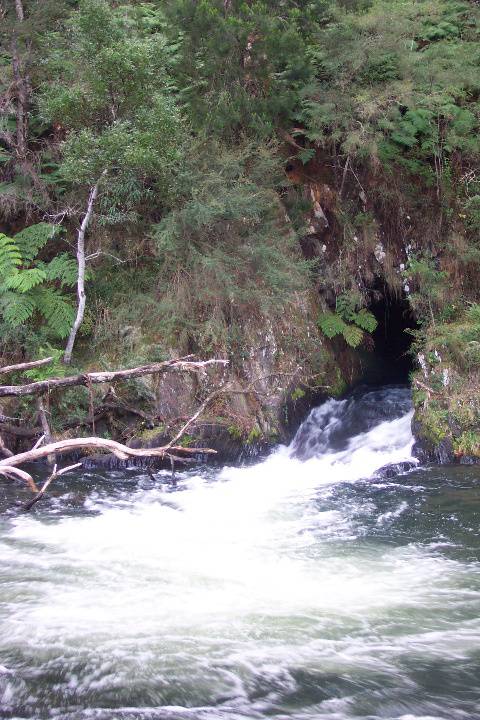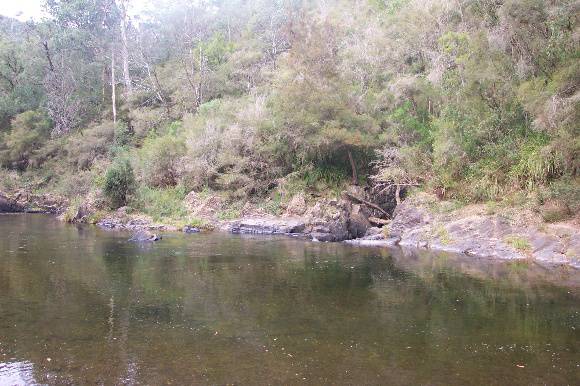| Back to search results » | Back to search page » |
|
Thomson River Diversion Tunnel & Horseshoe Bend riverbed alluvial mining area.
Location1.5 km below junction of Stringers Creek & Thomson River, 4km SW of Walhalla, WALHALLA VIC 3825 - Property No B7176
File NumberB7176LevelState |
|
Statement of Significance
What is Significant? The Thomson River Diversion Tunnel and Horseshoe Bend are located about 4km south-west of Walhalla in Gippsland, 1.5km below where Stringers Creek joins the Thomson River. The tunnel was driven through a ridge of land called Stockriders Spur, around which the river formed a horseshoe bend.
Diversion tunnels facilitated alluvial gold mining along the former courses of rivers. After completion, the river would flow through the tunnel, allowing (in summer time) most or all of the flow to be diverted so that the river bed could be sluiced for alluvial gold. In winter the volume of water flow would probably resume the former course, making sluicing very difficult. The sluicing resulted in a river bed stripped of gravel and loose material.
Construction of the Thomson River Diversion Tunnel by the Thomson River Alluvial Gold and Tailings Recovery Company was begun in August 1911. Work started at the outlet end and the tunnel was driven at an incline through the slate rock. Construction was completed around October 1912 by blasting through rock at the inlet end. The total length of the tunnel is about 561' (171m). The tunnel is not straight, but reportedly has a sharp change of angle below the entrance and again near the outlet. The entry and exits of the tunnel together with the river bed around Horseshoe Bend with its rocky bars and exposed bed rock contribute to the significance as the most visible evidence of the scope of the undertaking.
The fortunes of the Thomson River Alluvial Gold and Tailings Recovery Company are not known, but the working of the horseshoe bend of the Thomson River is not believed to have brought significant dividends. Alluvial mining was never a major feature of the Walhalla field, being confined to sluicing on the beds and banks of Thomson River and its tributaries. In 1886, the mining surveyor observed that nearly all the beds had at some time or other been passed through the sluice-box.
How is it significant? The Thomson River Diversion Tunnel is of historical, social and archaeological significance to the State of Victoria.
Why is it significant? The Thomson River Diversion Tunnel is historically and archaeologically significant as evidence of one of the dying stages of an industry that had dominated Gippsland for over fifty years. The settlement of the Walhalla area from the mid 1860s had been on the basis of reef mining. With the rapid decline in the fortunes and subsequent closure in 1914 of such prolific mines as Long Tunnel, the sluicing of this part of the Thomson River was one of the last initiatives aimed at winning payable gold from a source that had yielded gold in the 1860s, 1870s and 1880s. Sluicing for alluvial gold in the Thomson River in 1912 had turned the Walhalla wheel full circle from the first prospectors working for gold in Stringers Creek in the early 1860s. The tunnel is significant as one of the last and longest diversion tunnels constructed for winning gold in Victoria, and is a good example of this type of mining clearly demonstrating how effectively the miners adapted the natural features to divert the river flows. The tunnel effectively carries the water from the entry to the exit pool and the bare rocky bars in the original river course provide evidence of the mining works that were accomplished as a result of the construction of the tunnel.
The Thomson River Diversion Tunnel and Horseshoe Bend Riverbed are important as components of one of Victoria's most evocative gold mining landscapes, which is socially significant to the whole of Victoria. The tunnel and riverbed contribute to a unique cultural and historical landscape, which was dominated by gold in the nineteenth century, but a landscape with little permanent evidence of its former importance.
Classified 30/05/2011
Group
Mining and Mineral Processing
Category
Diversion Tunnel






